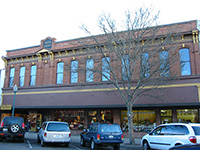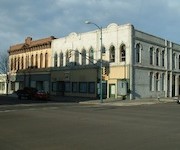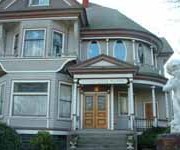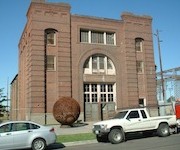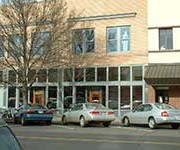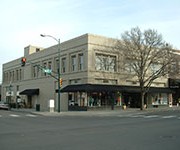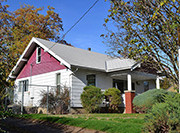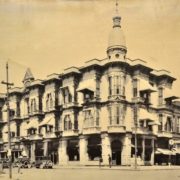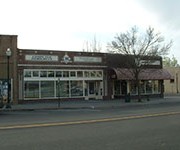History of Seil Building – 14 East Main Street, Walla Walla, WA
Legal Description (abbreviated):
the property consists of the west half of lot 4, the east half of lot 3, and 24 feet of the east half of lot 3 in Block 13 of the Original City of Walla Walla, 84 feet along the south side of Main Street by 120 feet, which extends south to the alley.
Tract 1: the west 24 feet by 120 feet of the east half of lot 3.
Tract 2: the east half of lot 3 (30 feet by 120 feet).
Tract 3: the west half of lot 4 (30 feet by 120 feet).
Title and Occupant History:
March 12, 1866–the City of Walla Walla conveyed several lots to H. P. Isaacs, including tract 1, for $30. (Deed Book F, Page 374; hereinafter F/374)
Henry P. Isaacs started several flour mills in eastern Washington, Idaho, and Oregon (1858 in Ft. Colville, 1862 in Walla Walla, 1864 in Boise, 1865 in Middleton, Idaho, 1883 in Prescott,. and 1898 in Wasco, Oregon). W. D. Lyman referred to him as lithe foremost miller on the Pacific coast” in his History of Walla Walla County (W.H. Lever, 1901, p, 313). Isaacs also successfully experiemnted with almost every variety of fruit and vegetable grown in the northern temperate zone and was a “booster” for Walla WAlia, encouraging rail lines in the valley and introducing the bill that established the state penitentiary in Walla Walla.
February 8, 1869–H. P. and Lucie Isaacs, husband and wife, sold tract 1 to George W. Somerindyke for $800. (F/307)
G. W. Somerindyke is listed in the 1880 city directory as the proprietor of a bag factory on the north side of Avenue street. The 1889 directory lists Somerindyke & Livermore as dealers in real estate and loans, located at 4 East Main St.
September 9, 1869–the City of Walla Walla conveyed part of tract 2 and all of tract 3 (total of 42 feet by 120 feet) to J. G. Venningerholz for $10. (F/553)
November 30, 1869–the City of Walla Walla conveyed part of tract 2 (18 feet by 120 feet) to J. G. Vennigerholz for $5. (F/613)
July 27, 1876–John George Vennigerholz, Sr. sold 18 feet by 120 feet of tract 2 to James H. Lasater for $1390. (N/363)
The 1880 city directory lists J. H. Lasater as an attorney at law with offices and residence at the south end of 3rd street.
April 16, 1883–John G. and Charles G. Vennigerholz, sons of John G. Vennigerholz, deceased, sold 42 feet by 120 feet (tract 3 and part of tract 2) to James H. Lasater for $9000. (28/487)
October 7, 1885–Party Wall Agreement was made between James H. Lasater (owner of tracts 2 & 3) and George and Mary A. Somerindyke (owners of tract 1). Both parties were about to erect brick business houses on their respective tracts and agreed to construct a party wall between them. (82/73)
1885-1897–Sometime in this period, James Lasater split the property he owned into two tracts, each 30 feet by 120 feet. Tract 2, with its part of the building, was sold to Elron and Alice Edgerly, husband and wife, and tract 3 was retained by Lasater.
Construction of the Building: from the information above and from the pictures in R. A. Bennett’s Walla Walla: Protrait of a Western Town. 1804-1899 (on p. 108 labelled, incorrectly, 1882; on pp. 145-146 in 1889; and on p. 154, in the early 1890s–all of which show both buildings completed), it seems likely that George W. Somerindyke built a building on tract 1 and James H. Lasater built a building on tracts 2 & 3, both of which were probably completed in 1886. A brochure printed by The Historical Architectural Development Corporation of Walla Walla in 1988 lists the Somerdyke [sic] Building circa 1887.
July 30, 1891–George W. and Mary A. Somerindyke, husband and wife, sold tract 1, with a building on it, to B. L. Sharpstein for $9250. (49/281)
B. L. Sharpstein was a lawyer who came to Walla Walla in 1865. He soon rose to prominence and was elected to the territorial legislature three times. He was a. member of the Constitutional Convention of 1889, active in education issues (Sharpstein School is named for him), and was one of a board of three that selected Walla Walla as a site for the state penitentiary.
August 9, 1894–B. L. and Sarah J. Sharpstein, husband and wife, sold tract 1 to John F. McLean for $10,000. (56/205)
December 17, 1897–Alice M. Edgerly (owner of tract 2) conveyed a right of way to James H. Lasater for the purpose of reaching the second story of the building now constructed on the Lasater property (tract 3) immediately west of the Edgerly property.
April 17, 1901–James H. and Elsie A. Lasater, husband and wife, sold tract 3 to Nicholas Seil for $14,000. (75/379)
In the 1891 Review of the Industries of Walla Walla (Whitman College Archives), N. Seil is listed as a manufacturer of, and dealer in, boots and shoes located at No. 20 Main Street. “No merchant manufacturer in Walla Walla has built up a more worthy reputation for square and honorable dealing in all things, large and small, than Mr. N. Seil, whose large boot and shoe emporium is one of the most prominent features on Main street.” (p. 84)
February 28, 1902–John F. and Ida McLean, husband and wife, sold tract 1, “on which the Somerindyke Building is situated,” to Jacob Betz.
Jacob Betz was a German brewer who came to Walla Walla in 1874. He owned and operated the Star Brewery and was active in city politics.
April 8, 1903–Elron E. and Alice M. Edgerly sold tract 2 to Nicholas Seil for $15,000. (85/415)
March 16, 1910–Party Wall agreement between N. Seil and Jacob Betz for Seil to extend existing wall, between tracts 1 & 2, forty feet to the alley. (122/621)
May 2, 1910–N. Seil was issued building permit #773 for an addition to his store of $6,752. The builder was M. J. McLeod. (Building Permit Book 1907 -13, page 96, Whitman College Archives)
November 7, 1910–Party Wall agreement between Nicholas and Susan Seil and Lettice J. Reynolds for 80 foot wall of two stories and 40 foot wall of one story along west line of Seil property (west line of tract 3). (122/620, see also #282353, filed February 2, 1945)
November 22, 1912–Jacob Bstz’s will was probated. All property, including tract 1, was bequeathed to his widow, Augusta Betz. (#143189, see also #143024)
June 23, 1924–Augusta Betz, a widow of Tacoma, sold tract I to Susan Seil, a widow, Emma K. Seil, and Edward F. Seil for $10 “and other good and valuable consideration.” (Deed #143283)
November 24, 1926–Party Wall Agreement between Susan Seil, et. al., and the property owner to the east, Peoples State Bank (owned east 6 feet of lot 3 and west 13 feet of lot 2 in Block 13) giving right to Peoples State Bank to build an extension of the party wall. (#163809)
February 20, 1976–Edith C. Seil, Margaret S. Gose, and Suzanne S. English conveyed tracts 1, 2, and 3 to Linn N. Buley, H. W. Thompson, and Eugene W. Valaer (doing business as G.S.L. & Associates, a partnership) for $10 “and other valuable conslderation.” (#8506118)
September 9, 1985–Claire E. Valaer, a single woman, quit claim deeded her interest in the property, in dissolution of marriage, to Eugene W. Valaer, a single man. (#8600126)
August I, 1989–Harvey W. and Betty P. Thompson, husband and wife, and Eugene W. Valaer conveyed their two-thirds interest in the property to Walla Walla Title Co., Inc., as nominee. (#8904963)
August I, 1989–Walla Walla Title Co., Inc., as nominee, conveyed and warranted an undivided two-thirds interest in the property to Linn N. and Marylois Buley, husband and wife.
Occupation of the Building:
The earliest lease in the deed records is in September 29, 1925 between Susan Seil et. al. and Diettrich Bros. for 5 years, March 1, 1926 to March 1, 1931, for 14 E. Main at $250/month. (#17940I)
May 21, 1929–Susan Seil et. al. leased Nos. 10 & 14 E. Main St. to J.J. Newberry Co., a Virginia corporation, for 25 years, June 1, 1929 to May 31, 1954. The rent was to start at $7500/ year and increase to $10,500/year.
Using city directories from 1880-1992, missing several editions:
10 E. Main:
Britt’s Variety Store, 1923-1929.
J.J. Newberry, 1930-1955.
Listed vacant in 1956.
Diamond’s 5 cent to $1 Store, 1957-1960.
Rasco 5-10-25 cents Store, 1961-1975.
Listed vacant in 1976.
Clarks Inc in 1977.
Denim Central Station in 1978-79.
Ginney’s Red Rooster in 1980-83.
Trails East Escrow, 1984-5
Chistian Supply Center, 1986-present
12 E. Main:
Walla Walla Title (+ Safeco in 1980), 1977 on, 12 1/2 in 1990
Blue Mountain Area Foundation, 1988-89
Professional Services Bureau, Wasser Agency, 1990 on
14 E. Main:
Eilers Music, 1907-1914
Diettrich Bros., grocers, 1916-1933
[Seil Building first listed in city directory in 1909-10] After 1933, list 10 and 16 on street level until 1977
16 E. Main:
Seil Shoe Store. 1883-1981
Christian Supply Center, 1982-85 Rug Rats. 1986
The Purple Parasol, 1987-1992
The Seil Building second floor had numerous firms and businesses through the years. Two notable examples:
John J. Arnold Photography Studio, 1919-1927.
George Schneller Optical, 1907-1926.
prepared by Michael W. Smith, 3/95

